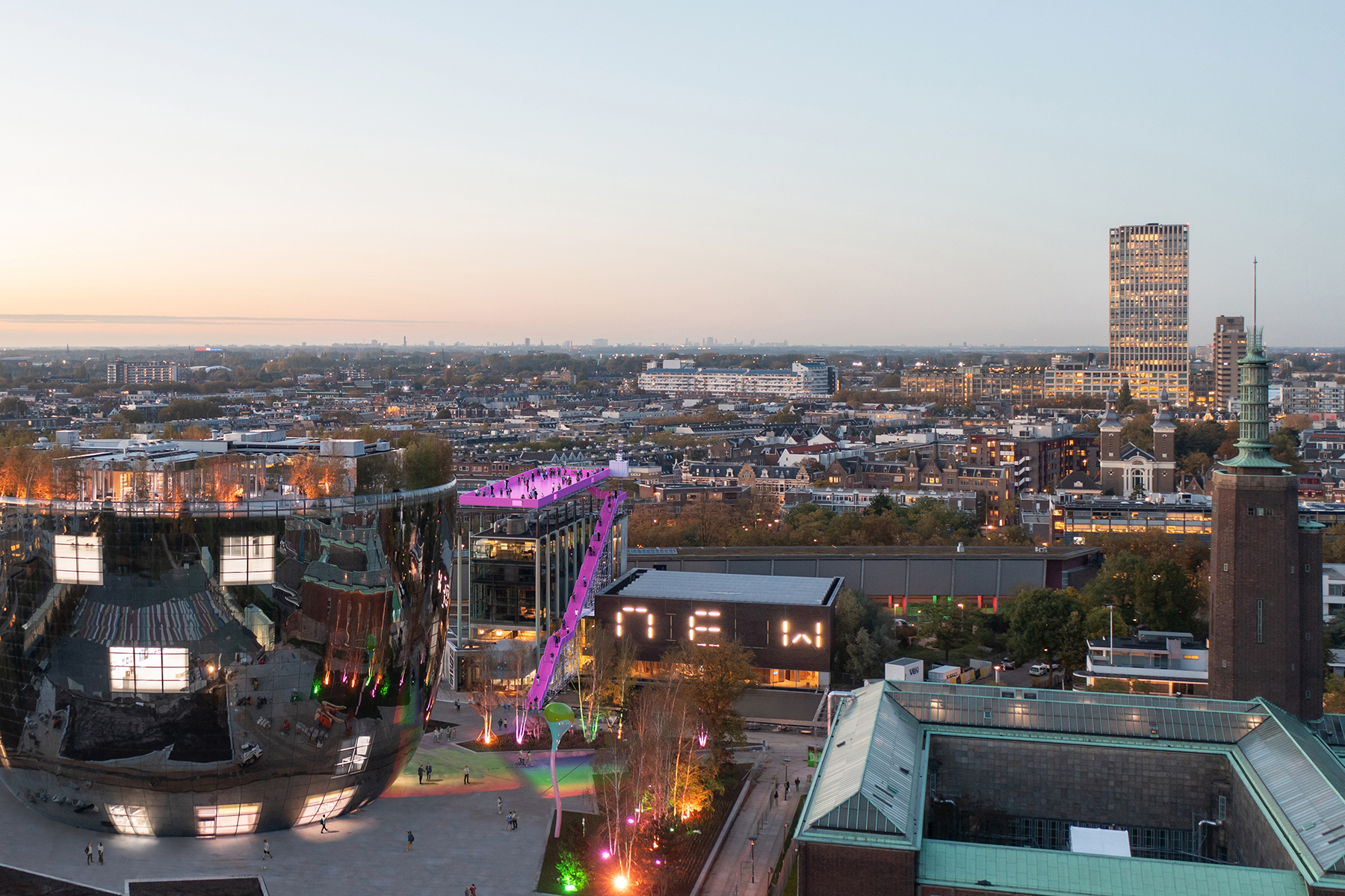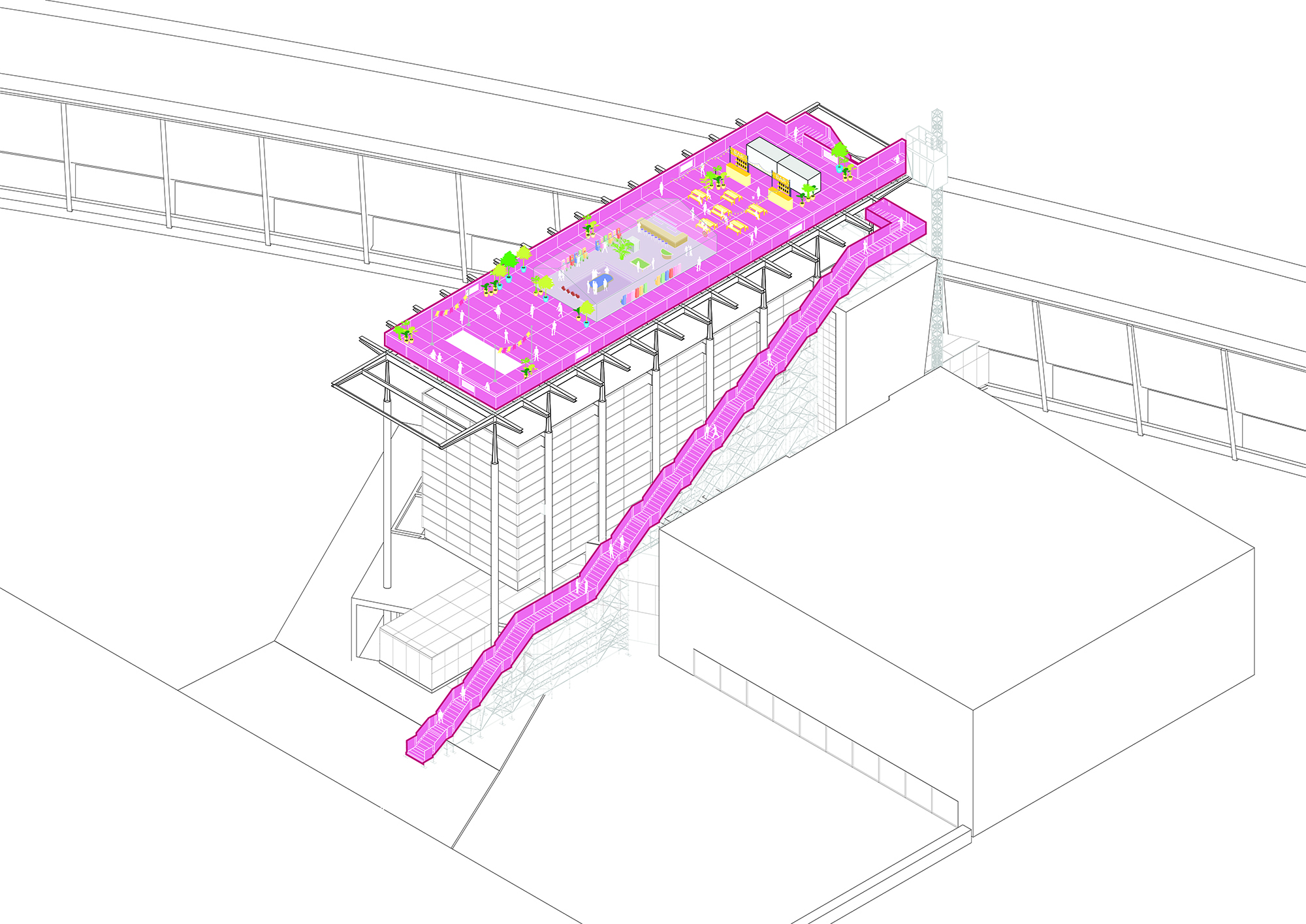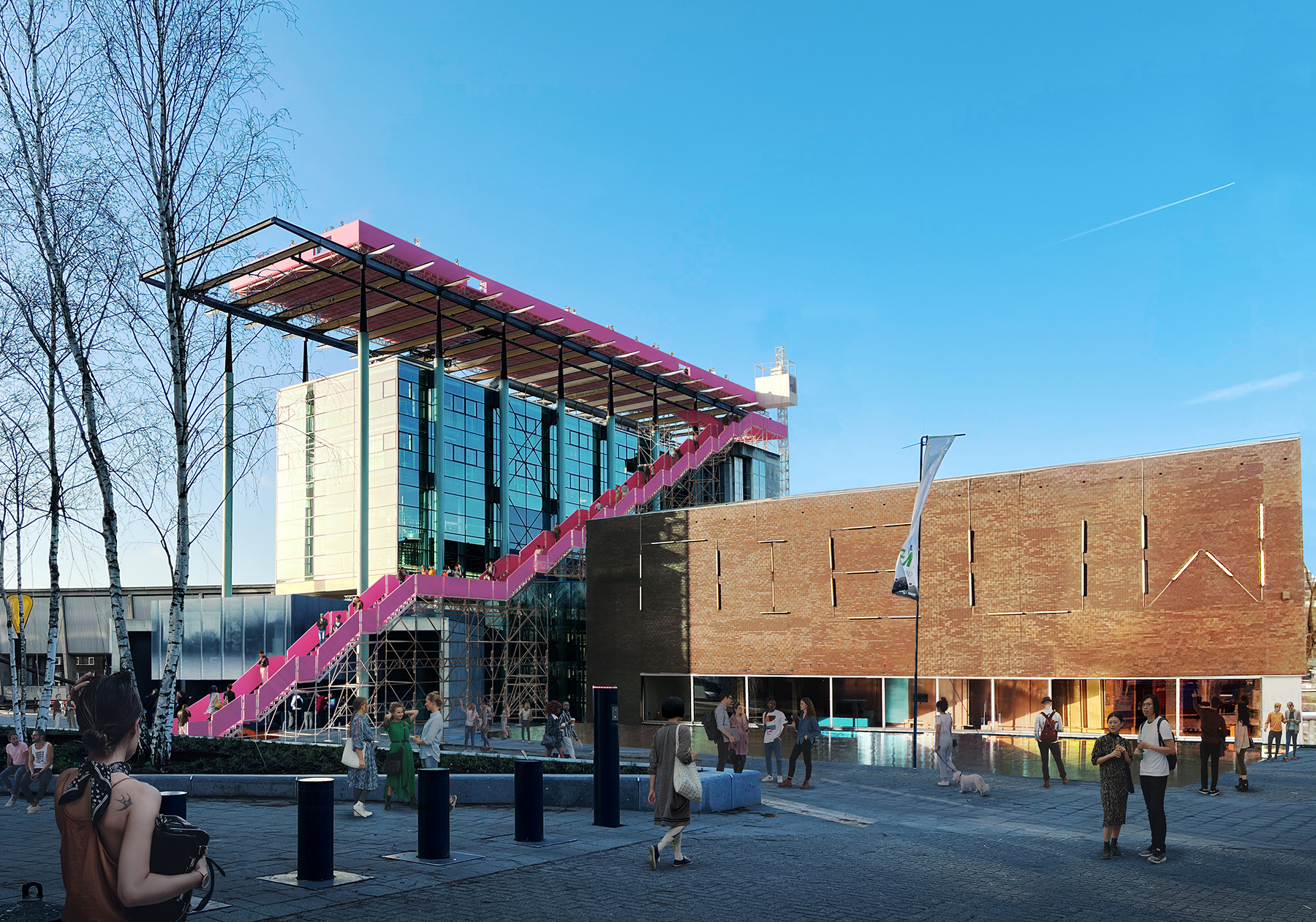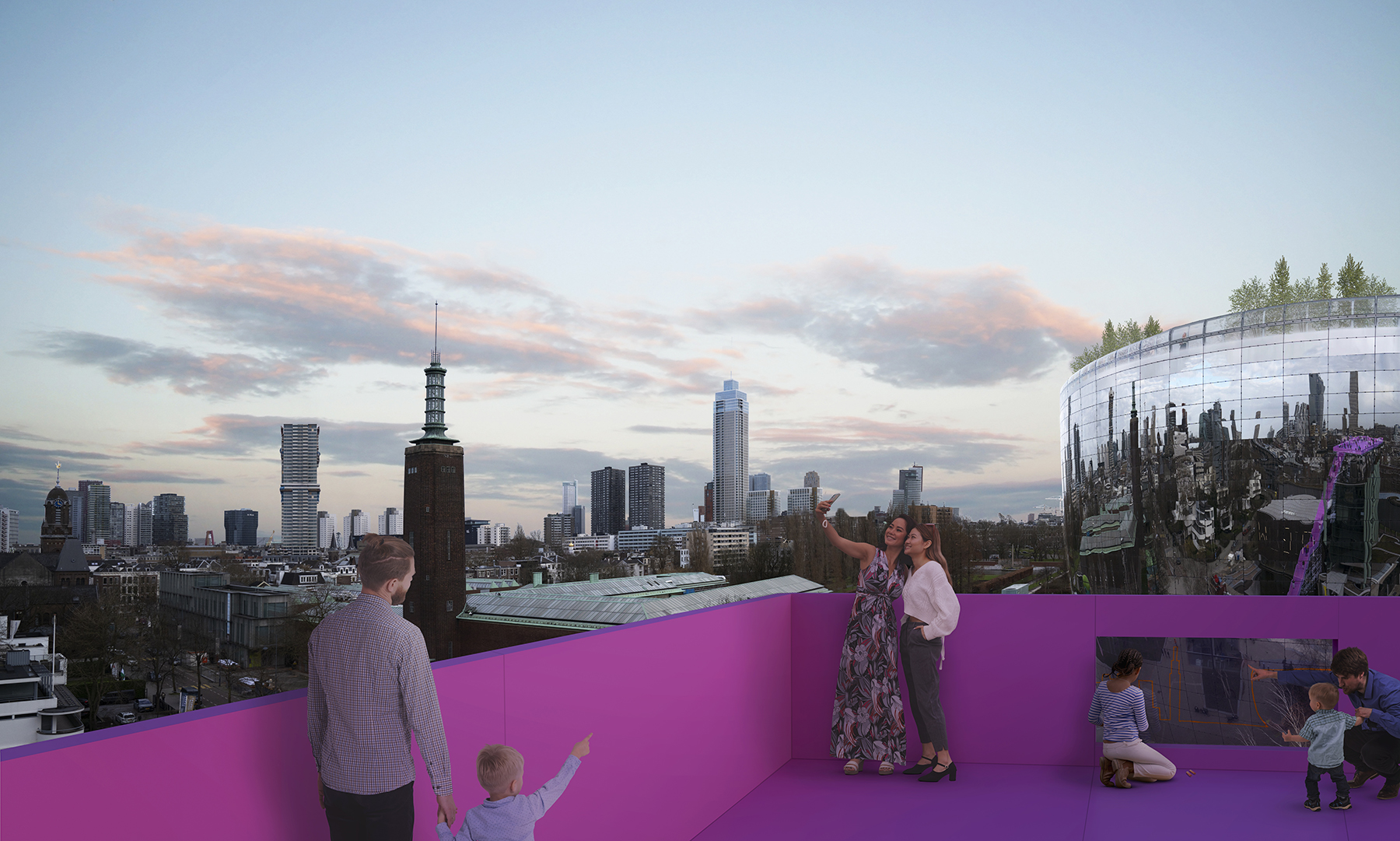By Jenny Jones
When considering methods for expanding the built environment, most people immediately think of constructing new structures or expanding existing buildings horizontally. But not the team at MVRDV. The Netherlands-based architecture firm is committed to maximizing urban density in an innovative way: reimagining building rooftops as usable spaces.
In its latest rooftop transformation effort, MVRDV is capping Het Nieuwe Instituut, a cultural center in Rotterdam, Netherlands, that focuses on architecture, design, and digital culture, with a temporary event and public gathering space known as The Podium.

Ablaze in striking hot pink, the temporary structure will include a set of 143 stairs that will scale the side of the institute and lead to a 600 sq m plaza extending across an existing pergola that hovers over the institute’s rooftop. The Podium will be in place and freely accessible for 11 weeks beginning in mid-June, giving visitors a fresh perspective on the city while also drawing attention to a new exhibit within the institute that features MVRDV’s work.
The open rooftop space can be potentially configured in a variety of different ways, depending on what type of event is being held.

"The institute was looking for a way to emphasize the fact that this exhibition was taking place there, and they were looking for a way to put the new institute building in the spotlight and draw a bit of attention to it,” says Gijs Rikken, an architect and associate design director for MVRDV.
"We proposed having this fantastic swooping stair to the roof and then using the existing pergola to create a viewing deck and event space. They immediately loved the idea of being able to ascend the stairs to the roof, seeing all these panoramas of the city, and then being able to descend from the viewing deck to visit the exhibition on the sixth floor before popping out again at the bottom of the institute.”
Load transfer
MVRDV is working with a scaffolding construction company called Dutch Steigers on The Podium. The stairs will extend 29 m up to the roof supported by an extensive scaffolding and coupling system and connect the viewing platform to HNI’s existing rooftop pergola.
The stairs, platform, and balustrade will be constructed of wood, and the base of the platform will be covered with reusable artificial turf for a parklike feel. The total project will weigh approximately 35 tons.

In response to written questions from Civil Engineering Online, Renee Heijmans, civil engineer and Leon Mulder, project manager, both with Dutch Steigers, said that the team conducted extensive research and calculations to ensure that the HNI building could carry the structural, wind, and live loads associated with the project.
"The wind load at this height has an impact on The Podium and the existing steel construction (on the roof),” Heijmans said. Wind loads were calculated both for in-service and out-of-service loads, with the difference being the live loading introduced by the visitors.
The calculations showed that the team could place The Podium on the existing steel structure with minor adjustments. “The existing steel is strong enough to withstand the vertical loads, but it is not strong enough to withstand the horizontal loads,” Mulder explained. “Therefore, steel cables will be installed to ensure the transfer of the horizontal loads to the existing construction. Clamps will be used to attach the cables to the existing construction to ensure that no permanent damage is caused.”
Source of inspiration
Construction of The Podium is scheduled to begin in May and expected to take approximately a month to complete. Its opening will coincide with Rotterdam Architecture Month, which begins June 1, and will be used as part of the festivities.
The Podium will also be the site of sporting events and other activities while it’s in place.
“All of these different people are interested in utilizing this unique space,” Rikken says. This includes a group that would like to do a stair run up and down the stairs.
“It’s really great to see that everybody sees the potential of something like this,” Rikken says. “This pergola structure is an existing structure that was there for aesthetic purposes mostly, and now we’ve made it into something functional, at least — in this case — for 11 weeks.”

Even when specialty events are not occurring on the site, Rikken says he hopes the project will inspire visitors in various ways. One way the team hopes to capture the project’s impact is through children. The Podium balustrade will feature plexiglass windows that will not only allow children to enjoy the views without struggling to see over the railing but also will give them a place to sketch. “We will actually have a couple of Magic Markers stuck on the wall right next to the windows so they can draw onto the plexiglass,” Rikken explains. “We will invite them to share their thoughts on the city.”
Underused element
The Podium furthers MVRDV’s established commitment to rooftop transformation. The firm has taken similar approaches with other projects, including a temporary structure known as The Stairs to Kriterion, which adorned the nearby Rotterdam Central Station in 2016.
Erected as part of a cultural event, The Stairs project symbolized the city’s 75 years of reconstruction in the aftermath of World War II. Like The Podium, it was a temporary structure.
In keeping with their sustainability goals, MVRDV and Dutch Steigers repurposed many components of The Stairs once the project was completed. The scaffolding went back to the warehouse to be used in another project, and much of the wood from the 140 risers was turned into benches that people could purchase.
“Now, throughout the whole city of Rotterdam, there are a lot of people that very proudly display their ‘trap bankje,’ which means stair bench in Dutch, that was made from this iconic structure,” says Rikken, adding that the team plans to do something similar with materials from The Podium.
In addition to delivering projects that illustrate the potential uses of rooftop spaces, MVRDV has written a book on the subject.
In 2021, the city of Rotterdam commissioned the firm to write the book in coordination with Rotterdam Rooftop Days, a celebration of the city’s rooftop landscape. The 148-page Rooftop Catalogue features 130 ideas for using available rooftop spaces throughout Rotterdam, including for playgrounds, parks, housing additions, solar panels, and water retention.
"We fully believe that there is a possibility to build denser without actually compromising on the quality of the built environment, and the roof is a very exemplary element within this agenda,” Rikken says.
“When you share these ideas for using rooftops in innovative ways, you start to show that there are surfaces in the built environment that we are underusing that could actually help us live in healthier, more energy-efficient, denser cities that take some of the stress off of the natural environment.”



